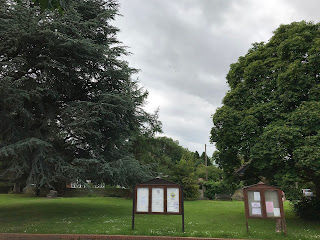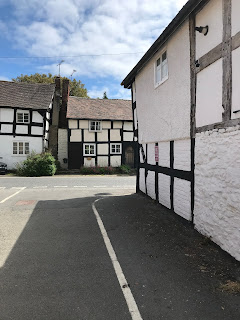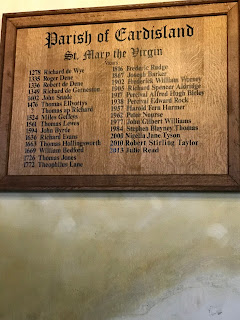I’ve always been intrigued by the term 'Chocolate Box Art, not with regard to its origin; Richard Cadbury was the culprit. Son of the founder of Cadbury's chocolate he designed his chocolate boxes using his own paintings. The phrase then adopted a life of its own, coming to mean any painting critics labelled as kitsch.
No, what puzzles me is its longevity as a phrase. Chocolate boxes haven't used scenic covers for years - you will find them on biscuit tins—but virus like the phrase has moved on from its original host and is currently residing in Herefordshire.
The Black and White Trail is a circular route, beginning and ending in Leominster and rivals the Cotswolds for picturesque villages. The term black and white comes from the manner of construction, ie timber frames from green oak, each beam cut to size were it was felled. The timber was numbered and assembled on-site. The space in between the frame was infilled with rubble or wattle and daub and whitewashed with limewash for added protection. The unseasoned oak eventually turned black with age, hence the black and white appearance of the houses.
On a fine summer’s day, we drove through Dilwyn, Weobly, Sarnesfield, Kinnersley, Eardisley, Kington, Lyonshall, Pembridge, and Eardisland. It was like driving back through the 1950s on empty roads and countryside bursting in green.
Weobley is one of the best-preserved Tudor villages in the country and like Leominster, the ‘o’ is silent, so they are respectively pronounced Webbly and Lemster. (Just to confuse Americans and Scousers) The name comes from a Saxon chief ‘Wibba’ and ‘ley is a Saxon name for glade. So long ago, it would have been known as Wibba’s woodland clearing. It’s mentioned in the Domesday book as Wibelai held by an Eadwig Cild before it was granted to the Norman Roger de Lacy. South of Broad Street are the remains of a castle first recorded during the mid C12th civil war between Stephen and Matilda and, during a later civil war, Charles I stayed in the Unicorn Inn formerly sited on the corner of High Street and Hereford Street.
A more permanent though less famous resident was James Tomkins. He had a cottage in the centre of the village. It was the C16th and he used his time wisely. Tomkins fathered 33 children by two wives and is remembered in verse
Babes thirty three did from two mothers spring,
To famous Tomkins, O, admired thing!
And may the loud resounding trump of fame,
Proclaime great Tomkins for a man of men.
The two wives have left no comment.
After Weobley, and having whipped through Sarnesfield*, Kinnersley, Eardisley, we were starving and needing liquid refreshment. Kington sounded a nice place to stop, but in this respect we were disappointed. Everything was shut or closing.
This soured things. It was all well and good being another village mentioned in the Domesday Book of 1086, all well and good being recorded as Chingtune from the old English Cyne Tun meaning royal manor and that the Normans built a castle on the high ground above the river and the town itself spread from its base. It was all very well that here lies the tomb of Sir Thomas and Lady Ellen Vaughan; that Thomas was known as Black Vaughan who died in the Battle of Banbury in 1469 and came back as the Black Dog of Hergest, the source of the Hounds of the Baskervilles. We cared not a fig. We eventually found food, in my case a cheese and pickle sandwich, and moved on.
The last two villages are gems. First Pembridge built near a ford across the River Arrow—which supplied drinking water to the village. Drinking water wasn't put on tap until 1960. Like the other villages on the black and white trail it predates the Domesday Book and was granted the right to hold fairs in 1239: the Cowslip Fair in May and the Woodcock Fair in November. Most of these timber framed houses date back to the C15th – Bishop Duppa’s Alms-house on Bridge Street being a C17th Johnny-come-lately
The river Arrow which connects many of these villages
The parish church of St Mary has one of only seven detached Bell Towers in the county. Behind the church are traces of the castle owned by the powerful Mortimer family. When Edmund Mortimer died in 1435 the land was passed on to Richard Duke of York.
Eardisland was once a Bronze age settlement, later held by Morcar, the Saxon Earl of Northumberland, seized by William the Conqueror and given to Baron William de Braose by the Conqueror’s son. It ended up in the hands of Richard Duke of York via marriage, forfeited to the crown and held briefly by Catherine of Aragon and her daughter Mary I.
Set farther back from the C13th Church is a moated motte, all that remains of a castle defending the land from the Welsh. Now visitors are provided with afternoon teas.
At Sarnesfield is the grave of John Abel , Carpenter to Charles I. I wanted to pay my respects but time didn't allow. Retrospectively distraught.





































